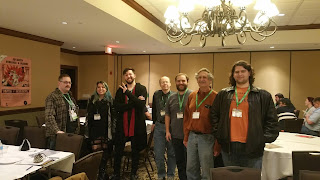For the Thor film, it was decided to highlight the Shakespearean nature of the character (not actually present in the earliest stories, but a significant feature later on) by hiring a Shakespearean actor.
Kenneth Branagh was directing and starring in Henry V, but Universal was certain that Kenneth was perfect for the role of Thor and convinced him they could accommodate his Henry V schedule by filming in England (instead of on location in Norway), and using Don Blake instead of Thor as much as possible in the film. Kenneth also insisted that, in future films, his friend and frequent collaborator Brian Blessed would get to play Odin. Kenneth could not bulk up for the film, so some modifications were made to Thor's costume, such as giving it armored sleeves (and a long blonde wig, of course).
Previous adaptions had been able to stick pretty close to the original source material, only combining two issues at a time and fleshing them out with more detail, character nuance, and interaction. This time, they were making a 117 minute movie which they had promised Kenneth would only feature Thor in 60 minutes of -- and they only had one issue to work with because Thor's second appearance (stopping a new civil war in Spain being instigated by Russians) was garbage.
The solution was to bring in Nurse Jane Foster early (she was not featured in Thor's original origin story). To lend gravitas to the story, Don Blake was not on vacation in Norway, but was returning to his ancestors' homeland to die. His nurse had come, then, not on vacation, but to be his caregiver in his final weeks. When what seems to be a meteor strike causes horrific damage in Norway, Don and Jane pitch in to help the injured (this is borrowed from the set-up of Thor's second appearance). Of course, the strike is actually the ship of the Stone Men landing. This time, instead of being an isolated invasion, these are the shock troops of the Skrulls (tying all the Marvel movies together so far).
Since the "will they/won't they" relationship between Don and Jane has to carry more of the movie, Meg Ryan was cast as Jane Foster (she was still an unknown, as When Harry Met Sally came out a few months later) based on the strength of her audition. Don Blake was cast as Tim Robbins, who had just made it to the big time last year with Bull Durham. Tim famously lost a lot of weight for the part so he would look sickly and weak, worrying the physicians who were on hand for the filming.
Lastly, though animatronics for the previous movies had been handled by smaller companies, it was decided with Thor that Jim Henson Studios had to be brought on board to provide the animatronics from now on. To stretch out the film, the Stone Men were given characters and conflicting agendas, which meant the audience had to be able to be able to empathize with them -- something Jim Henson had pioneered with nonliving characters.
The soundtrack was largely orchestral, featuring tracks from Wagner's operas, one of the biggest laughs in the movie is when Peter, Paul, and Mary break into "If I Had a Hammer."
Though critics hailed this as the most cerebral superhero movie to date, the studio was concerned that combination of romance, fantasy, and science fiction was a lot for audiences to process. However, Thor raked in $100 million, the best for a Marvel movie so far. This would have been cause for celebration normally, but 1989 was a big year for movies and $100 million did not even break into the top 10. Further, the smash hit Batman made Universal concerned that they might be on the wrong track with fun, heartwarming superhero films, when Warner Brothers won big by going dark...




















